Europa League 3rd Qualifying Round Draw: Rijeka and Lokomotiva Learn Opponents
September 1, 2020 - Rijeka and Lokomotiva have learned their opponents for the Europa League Round 3 qualifying draw.
On Monday, Hajduk and Osijek found out their opponents in Europa League's second qualifying round. Hajduk will play against the Macedonian club Renova away, and Osijek will play against Basel.
The draw for the third qualifying round was held today, and Rijeka and Lokomotiva joined Hajduk and Osijek in learning their opponents. In this phase of the competition, only one match will be played without spectators, and two matches will be played in the playoffs.
Lokomotiva away, Greek Aris or Ukrainian Kolos arrives in Rijeka
The first to be drawn was Lokomotiva, which moved to the Europa League after losing to the Vienna club Rapid in the Champions League. Lokomotiva will thus host the winner between Hungarian club Honved and Swedish club Malmo.
Rijeka did well in today's draw and will welcome Greek Aris or Ukrainian Kolos Kovalivka.
If Hajduk passes Macedonian club Renova, they will play against Azerbaijani club Neftchi or Turkish club Galatasaray. If Osijek throws out Basel, they will welcome Cypriot club Anorthosis at City Garden.
Hajduk - Renova and Osijek - Basel will be played on September 17, and the matches of the third qualifying round are on the program a week later.
Europa League Round 3 Qualifying Draw:
Rijeka (starts in the third qualifying round) - Aris (Greece) or Kolos Kovalivka (Ukraine)
Lokomotiva (joins in the third qualifying round after relegation from the Champions League qualifiers) - Honved (Hungary) or Malmö (Sweden)
Hajduk (if they knock out Renova) - Neftchi Baku (Azerbaijan) or Galatasaray (Turkey)
Osijek (if they knock out Basel) - Anorthosis (Cyprus)
For the latest travel info, bookmark our main travel info article, which is updated daily.
Read the Croatian Travel Update in your language - now available in 24 languages
HNL Round 3 Recap: Dinamo Tops Osijek, Hajduk and Belupo Draw
August 31, 2020 - The 3rd round of the Croatian First League was held from August 28 to 30, 2020. This round saw Dinamo top Osijek 4:1, and Hajduk and Belupo draw at Poljud. The 3rd round was played without the presence of spectators.
Gorica v. Sibenik (3:2)
Gorica and Sibenik opened the third round of the Croatian First League on August 28, 2020, in Velika Gorica.
Mudrinski opened the scoring for Gorica with a goal in the third minute for 1:0. Bulat had the chance to equalize in the 45th minute though he missed a penalty.
Lovric increased Gorica's lead to 2:0 in the 65th minute, and Babec made it 3:0 in the 75th. Rak scored in the 87th minute for 3:1, and Anocic in the third minute of added time for the final score of 3:2.
Gorica is currently in 2nd place with 9 points, while Sibenik is in 9th place with 0.
Rijeka v. Istra 1961 (2:1)
Rijeka and Gorica met on August 29, 2020, at Rujevica Stadium in Rijeka.
Andrijasevic scored the first goal of the game in the 13th minute for the 1:0 at the half. Andrijasevic scored again in the 69th minute for 2:0, though Guzina got one for Istra in the 70th for the final score of 2:1.
Rijeka is currently in 4th place with 6 points, while Istra is in the last place with 0 points.
Hajduk v. Slaven Belupo (2:2)
Hajduk and Belupo met on Saturday, August 29, 2020, at Poljud Stadium in Split.
Krstanovic scored a Belupo penalty in the 38th minute for 0:1 at the half. Diamantakos scored in his Hajduk debut for 1:1 in the 52nd minute.
Gyursco put Hajduk in the 2:1 lead in the 65th minute, though Bacelic-Grgic equalized for 2:2 six minutes later. Jairo received a double-yellow in the 85th minute, forcing Hajduk to play with a man down for the remainder of the match.
Hajduk is currently in 3rd place with 8 points, while Belupo is in 7th with 2 points.
Varazdin v. Lokomotiva (1:1)
Varazdin and Lokomotiva met on Sunday, August 30, 2020, at NK Varteks Stadium.
Mehdikhani scored just before the half for 1:0 Varazdin. However, an own goal by Rodin made it 1:1 in the 49th minute, which was the final score of the game.
Varazdin is currently in 5th place with 4 points, while Lokomotiva is in 6th with 4.
Dinamo v. Osijek (4:1)
Dinamo and Osijek closed out the 3rd round at Maksimir Stadium on Sunday, August 31, 2020.
Gavranovic opened the scoring spree for Dinamo with a goal in the 5th minute for 1:0. Majstorovic missed a penalty for Osijek right before the half.
Grezda equalized in the 48th minute for 1:1, though Ademi put Dinamo back in the lead with a goal in the 71st minute. Two penalties secured Dinamo's victory - one by Andric in the 81st and Tolic in the 86th.
Dinamo is currently in 1st place with 9 points, while Osijek is in 8th with 1.
You can see the full HNL table here.
For the latest travel info, bookmark our main travel info article, which is updated daily.
Read the Croatian Travel Update in your language - now available in 24 languages
Join the Total Croatia Travel INFO Viber community.
HNL Round 2 Recap: Hajduk Better than Osijek, Lokomotiva Tops Rijeka
August 24, 2020 - The 2nd round of the Croatian First League was held from August 21 to 23, 2020. This round saw big wins for Lokomotiva, Dinamo and Hajduk.
Lokomotiva v. Rijeka (1:0)
Lokomotiva and Rijeka opened the 2nd round on Friday, August 21, 2020, in Zagreb.
The first half went without goals, and it wasn't until the 53rd minute that Halilovic scored the only goal of the game for the Lokomotiva win.
Lokomotiva is currently in 6th place with 3 points, while Rijeka is in 4th with 3 points.
Istra 1961 v. Dinamo (0:1)
Istra and Dinamo met at Aldo Drosini Stadium in Pula on Friday, August 21, 2020.
After another scoreless first half, a double yellow for Kastrati saw Dinamo play with a man down from the 57th minute. Nevertheless, a Dinamo penalty was scored by Bruno Petkovic in the 87th minute for the 0:1 win.
Istra is currently in the last place with 0 points, while Dinamo is in first place with 6 points.
Slaven Belupo v. Gorica (1:2)
Belupo and Gorica met in Koprivnica on Saturday, August 22, 2020.
While Belupo was the first to score with a goal by Glavcic seconds before halftime, two late goals by Mudrinski in the 86th and 93rd minutes gave Gorica the win.
Belupo is currently in 8th place with 1 point, while Gorica is in 2nd with 6 points.
Sibenik v. Varazdin (0:1)
Sibenik and Varazdin met on Saturday, August 22, 2020, at Subicevac Stadium in Sibenik.
After Sibenik's Spanja received a red card in the 85th minute, Varazdin scored a late game-winner thanks to Benko in the 89th minute. The game ended 0:1.
Sibenik is currently in 9th place with 0 points, while Varazdin is in 5th place with 3.
Osijek v. Hajduk (1:2)
Osijek and Hajduk closed out the 2nd round on Sunday, August 23, 2020, at City Garden Stadium.
Hajduk was the first to score thanks to a header by Jairo in the 34th minute. A Caktas penalty two minutes later put Hajduk up 0:2 in the 36th minute. Jugovic scored for Osijek in the 43rd minute for 1:2, which was the final score of the game.
Osijek is currently in 7th place with 1 point, while Hajduk is in 3rd with 6 points.
All games were played without the presence of spectators. You can see the full HNL table here.
For the latest travel info, bookmark our main travel info article, which is updated daily.
Read the Croatian Travel Update in your language - now available in 24 languages
Join the Total Croatia Travel INFO Viber community.
EU To Extend Rijeka Capital Of Culture For 4 Months
August 19, 2020 – The European Union Commission proposal will give Rijeka Capital Of Culture more time to finish its grand plans
The European Commission today said they are proposing to extend ECoC status to Rijeka for four extra months. Authorities recognised that the city's long-planned Rijeka Capital Of Culture programme was not able to run due to the coronavirus pandemic.
Earlier this year, most public institutions – museums, galleries, theatres, music venues, bars, nightclubs, restaurants, hotels and all places of public gathering – were closed in Croatia for many weeks. Much of the Rijeka Capital Of Culture calendar of events had to be postponed or cancelled. Some artists due to visit Rijeka Capital Of Culture were also unable to reach the city. The programme all but ceased between March 2020 and June 2020.
However, some of the programme has since been successfully reinstated. The European Commission proposal may give the city more time to finish its grand plans. The offer is also to be extended to the city of Galway in Ireland, which shares Capital of Culture status with Rijeka this year. The proposed extension would mean Rijeka Capital Of Culture retains the title until April 30 2021. This would give the city one more opportunity to mark ECoC at its biggest annual event, the monstrous Rijeka Carnival, which concludes at the end of February.
Meet HGSS The Croatian Mountain Rescue Service
August 19, 2020 – All weather, all terrain, all year round – meet HGSS The Croatian Mountain Rescue Service, amazing volunteers who will never let you down
They're never far from the news. For the last two weeks, members of HGSS The Croatian Mountain Rescue Service have yet again been on the TV news every night. They're leading the search for a summertime visitor, a Polish hiker missing on Biokovo mountain.
But, watch again this winter and, for sure, they'll be in the headlines once more. Whether, they're scaling mountain ranges in the unbearable heat of high summer, searching underwater caves, flooded rivers or the sea, breaking through wild forest or trudging through metres of snow, they undertake their search and rescue missions over every terrain, in every weather condition, in every month of the year, all across Croatia. And, they all volunteers.
Marc Rowlands meets the head of service for HGSS The Croatian Mountain Rescue Service and three of its volunteers to find out who they are and what makes them do what they do.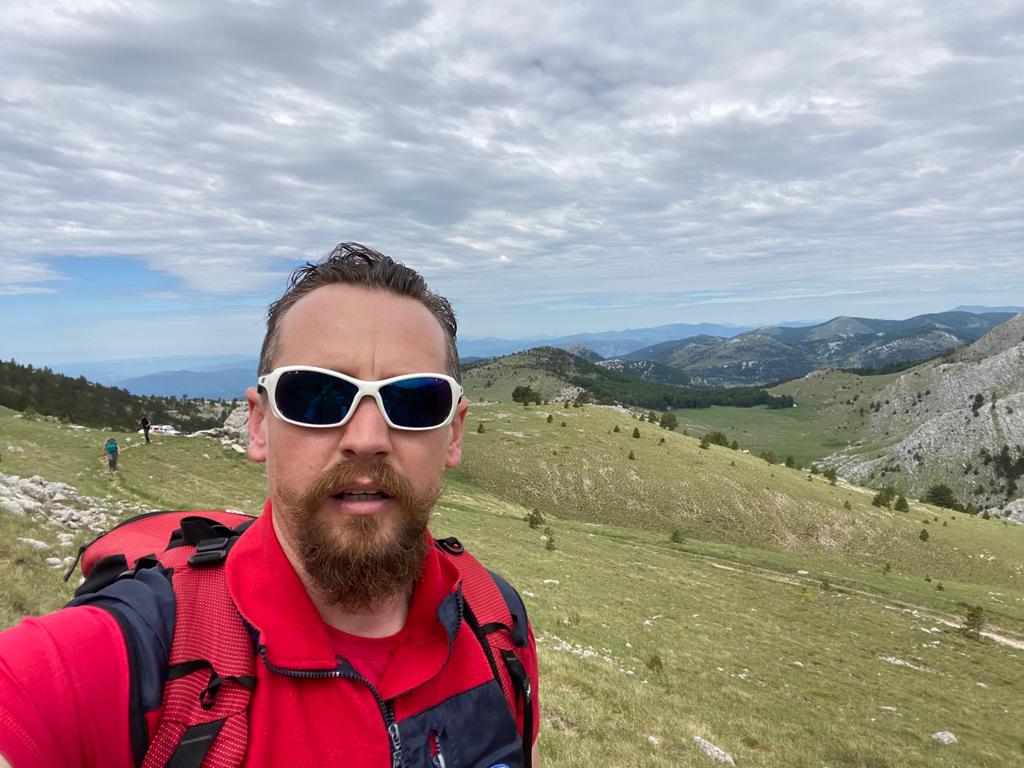
Josip Granić, head of service for HGSS The Croatian Mountain Rescue Service
My name is Josip Granić. I'm the Head Of Service for HGSS The Croatian Mountain Rescue Service. We've had an extremely busy couple of weeks. Being head of service for an organisation like this under such circumstances means you're always on the phone; co-ordinating, talking to outside organisations, members of the press. Communication. It's a 24/7 job, 365 days a year. If people need help, you can't take a holiday. Not at this level of the organisation.
We have around 1000 members. There are 11 paid positions in the main organisation and 25 people we pay to run the administration in each of the teams or stations we have. All of the members who perform the search and rescue are volunteers. We have pilots, surgeons, nurses, students, professors, every part of society.
I'm originally from Kaštela, but my home station is in Karlovac. I've been there for 15 years. I've been Head Of Service for two. Since I assumed the position, I've spent most of my time in the car. I travel all over Croatia.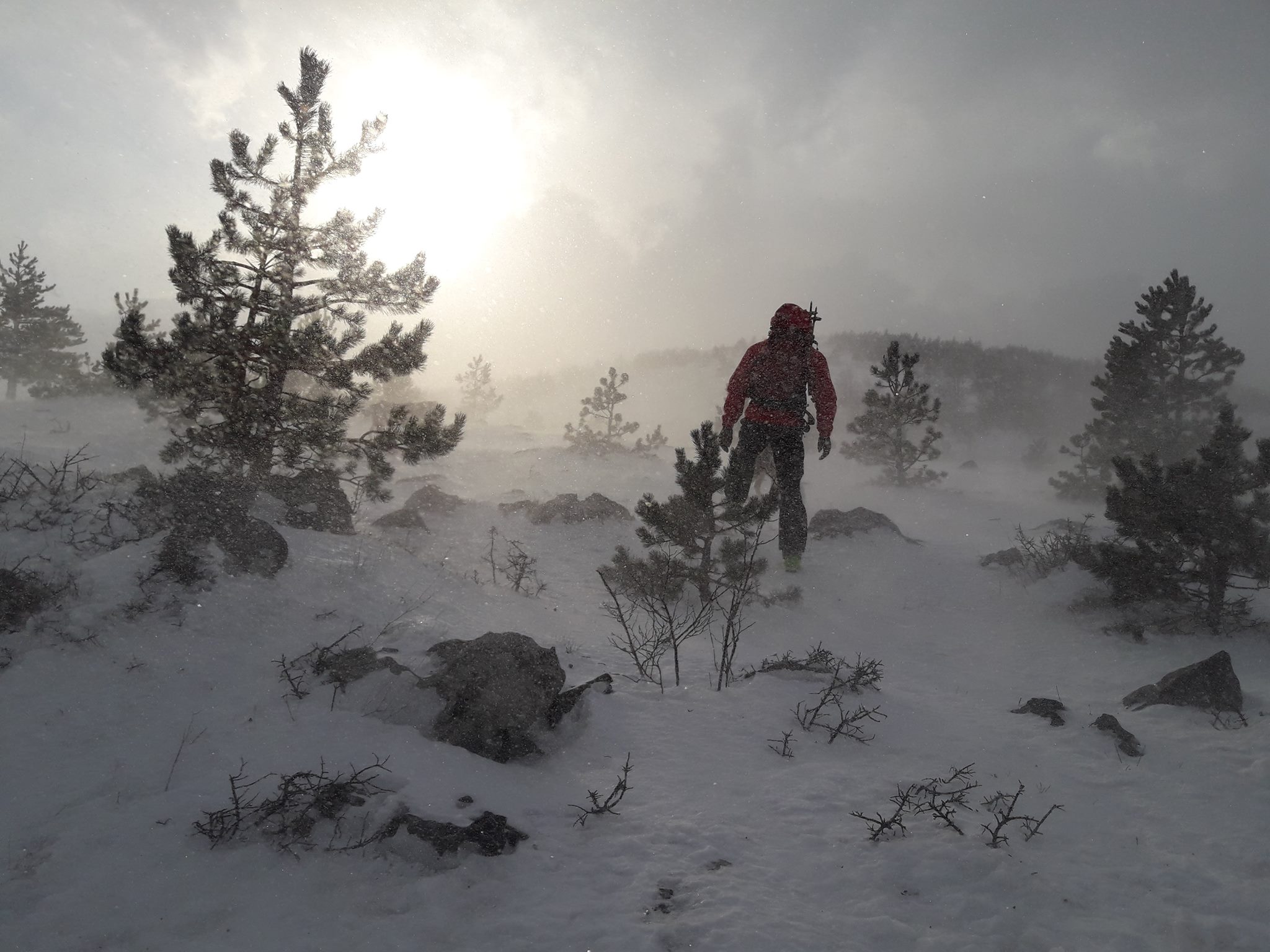
HGSS The Croatian Mountain Rescue Service missions can be hampered by extreme weather conditions © HGSS The Croatian Mountain Rescue Service
To get a certified position as a mountain rescuer in Croatia you all do the same training. It doesn't matter if you come from Slavonia, Dalmatia or Istria, you must have the knowledge and ability to deal with circumstances in any terrain; caves, pits, mountains, on snow, underwater.
Depending on where your station is, the type of call-outs you get could be very different. In Slavonia, 90% are for missing persons - searching forests, rivers, and in floods. We've had a big search on Biokovo mountain for the past 16 days. The stations from Split, Makarska, and Dubrovnik were at first involved, then teams from all over Croatia. It's not the same as Slavonia. The terrain is very different, so you have to be good at a particular set of skills. But, the largest percentage of call-outs is still missing persons. It's 70% of our work nationwide. The other 30% are rescues.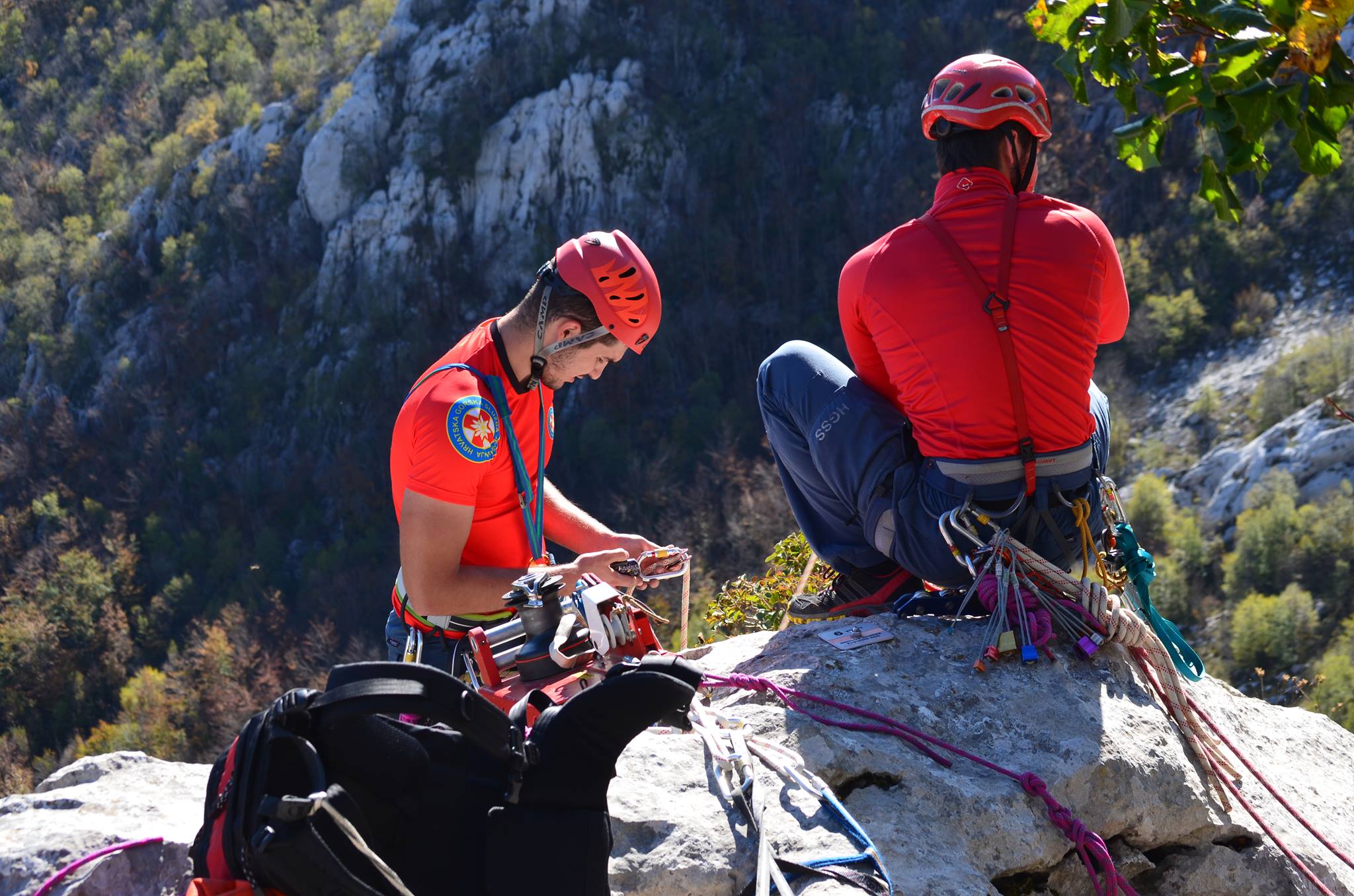
HGSS volunteers are educated to use a wide range of technical equipment. They are trained to operate in all the different kinds of terrain found across Croatia © HGSS The Croatian Mountain Rescue Service
There are usually 800 – 1000 missions a year across the country. We get roughly the same amount of calls in colder months as in warmer months. Only, winter months can be busier. The terrain is more difficult. There are some villages in Croatia – usually where the front line of the fighting was, around Karlovac, Kordun, Lika – and when it snows, it can be almost impossible to reach those places. But, some older people still live there. It can take days to reach them on snowmobiles, then skis, to deliver food or medecine. The other busiest places in winter are the ski resorts - Platak, behind Rijeka, and in Zagreb, on Sljeme. There are teams stationed in those places throughout the snow season.
What's the greatest danger of the job? Almost everything. Nothing in this job is easy. The greatest dangers we face are the same facing those that we rescue - underestimating the environment, nature, the conditions. That's where our training comes in.
In mountain rescue, we separate dangers into subjective, objective and technical. Subjective is the stuff you're guilty of - lack of preparedness, knowledge or equipment. Objective dangers are the ones you can't control, like sudden changes in weather, or avalanche. If you're sensible and informed, there should be no objective danger.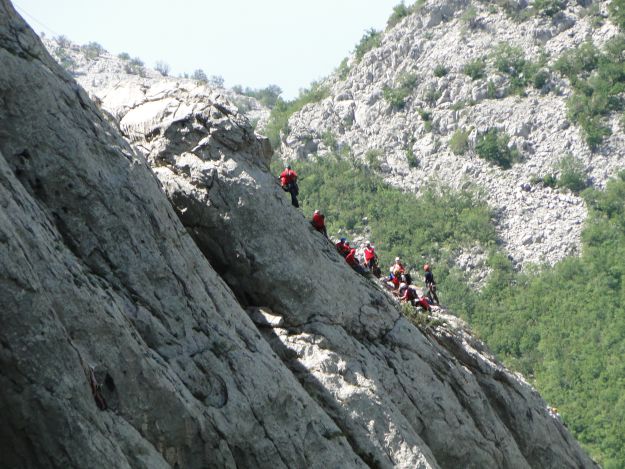
HGSS on a mission, clinging to a steep incline in Paklenica © HGSS The Croatian Mountain Rescue Service "People need to be aware at all times on the mountains. By the time most people think they may be in trouble, they've usually been in trouble for five or ten minutes already" Josip Granić.
80 – 85% of the people we rescue are Croatian. Only 15 – 20% are guests. People from Czech Republic, Slovakia, Poland, (Austria and Slovenia too) tend to enjoy nature more. They like hiking. That's the reason there are typically more rescues for those nationalities than there are for British, Belgian, French, Italian, America, Canadian or Australian guests. I don't remember the specific year, but sometime between 15 and 20 years ago we had a season where 5 or 6 Czech nationals were being searched for or, sadly, turned up dead. The media covered it and ever since there's been this myth that all the people who get into difficulty are Czech.
The question about expensive helicopter rides - why don't you charge the people you rescue - has been here forever. It's like this - if you're a tourist and you have a car accident in Croatia, the fire service, police and an ambulance will come. You won't get charged. We are a tourist country. According to international agreements, we are obliged to make everything safe for residents and guests alike. We are here, just like the fire service and police, to do our part. The Croatian air force is responsible for the helicopter rides and I have to give credit to them - they are crazy good pilots. Amazing. Even if we did charge everyone we saved - and most of the 85% of Croatians we save would struggle to pay - it still wouldn't be anywhere near the money required to run this service.
The Croatian Mountain Rescue Service used specially trained dogs on their searches © HGSS The Croatian Mountain Rescue Service
In 2007, I got a new search dog. It came from the Ogwen Valley Mountain Rescue service in North Wales. We cooperate a lot. We were sent out on a job to look for a three-year-old male child who had gone missing near Požega at the beginning of January, wintertime. His grandma was watching him and they were in a house on the edge of the woods. Early in the morning, he was playing with a dog. It suddenly ran into the forest and the boy chased after him. The grandmother didn't see it happen. I found him using my new dog, just after 8 o'clock the next morning. He'd been alone in the freezing forest for almost 20 hours.
Time is really moving fast on a job like that, because it's a kid and because it's so cold. Survival rates in such conditions are not good after 24 hours. When I found him, saw that he was alive, those big eyes looking up at me, it's a crazy feeling. You can't describe it. You can't compare it. A lot of positive emotions.
Every mission is special. We meet them all with the same level of determination and professionalism. But, it's the ones where you know you've really saved someone that stand out in the memory. Not the broken leg, where you transported someone – sure, that's an excellent job. But, when you know you've saved someone's life, that they definitely wouldn't be here now if it weren't for you, that's what makes it all worthwhile.
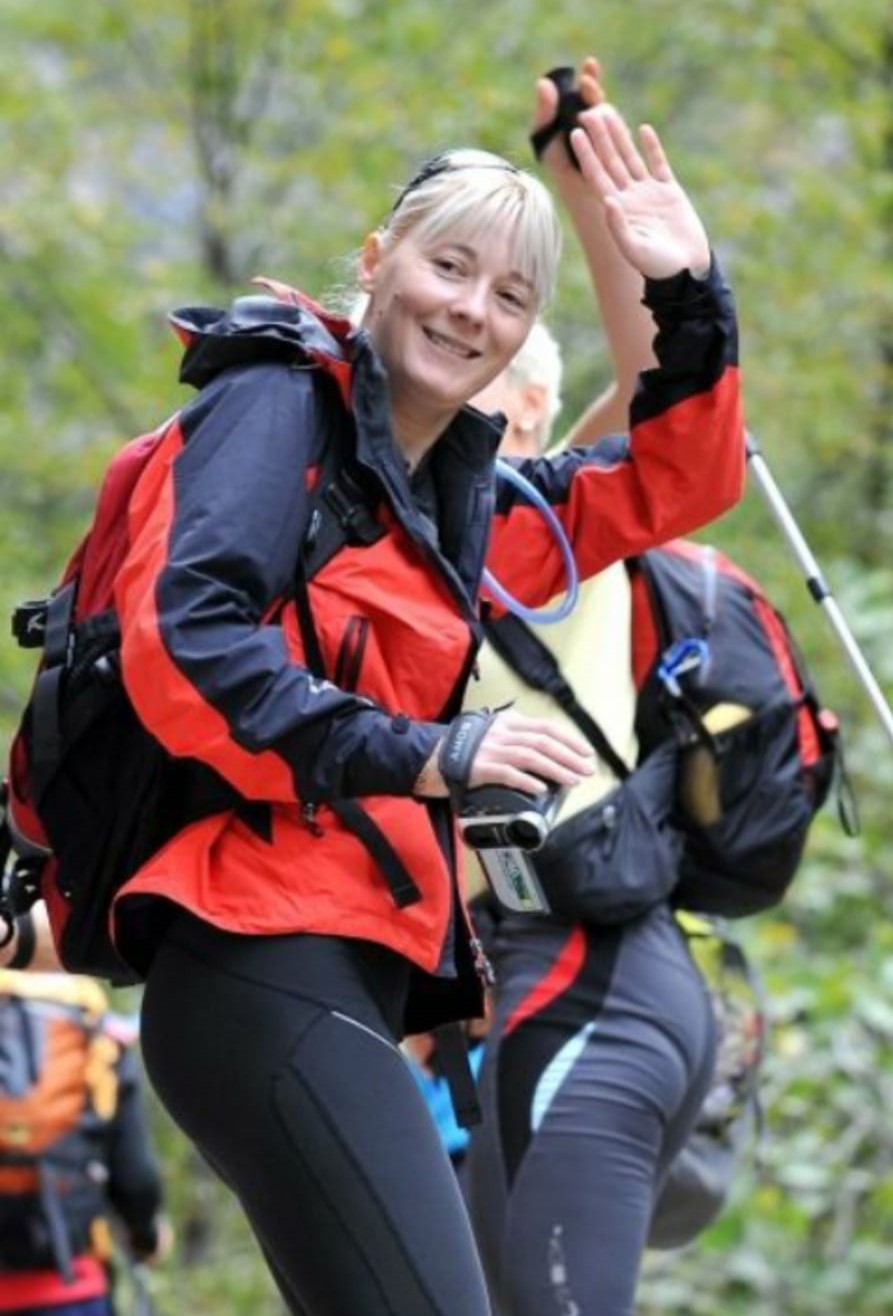
Jana Mijailović, volunteer for HGSS The Croatian Mountain Rescue Service
My name is Jana Mijailović, I'm 48 years old and I'm from Zadar. I finished school to be a teacher, but I never did it. My husband and I run a company that does plastic and aluminium windows for houses.
I started to go into the mountains when I was at high school. I never had the ambition to be part of mountain rescue services – people just noticed me on the mountains. They said I'd be good at it and asked me to join. I met my husband on the mountains. We are both volunteers for HGSS The Croatian Mountain Rescue Service. I've been doing it for 16 years.
I was a member of the first and second all-female Croatian expeditions to the Himalayas. We first climbed Cho Oyu in 2007, then Mount Everest in 2009. Croatia is the only country in the world that has only one successful male climber of Mount Everest, but four successful female climbers. I sometimes work as a guide too. I guess you could say I'm all about the mountains.
Being a climber, an Alpinist, I know that if I get into trouble, it's only my HGSS colleagues who can help. I feel this instinctively. I cannot be in the house, safe and warm, knowing that maybe someone needs help that only I can provide.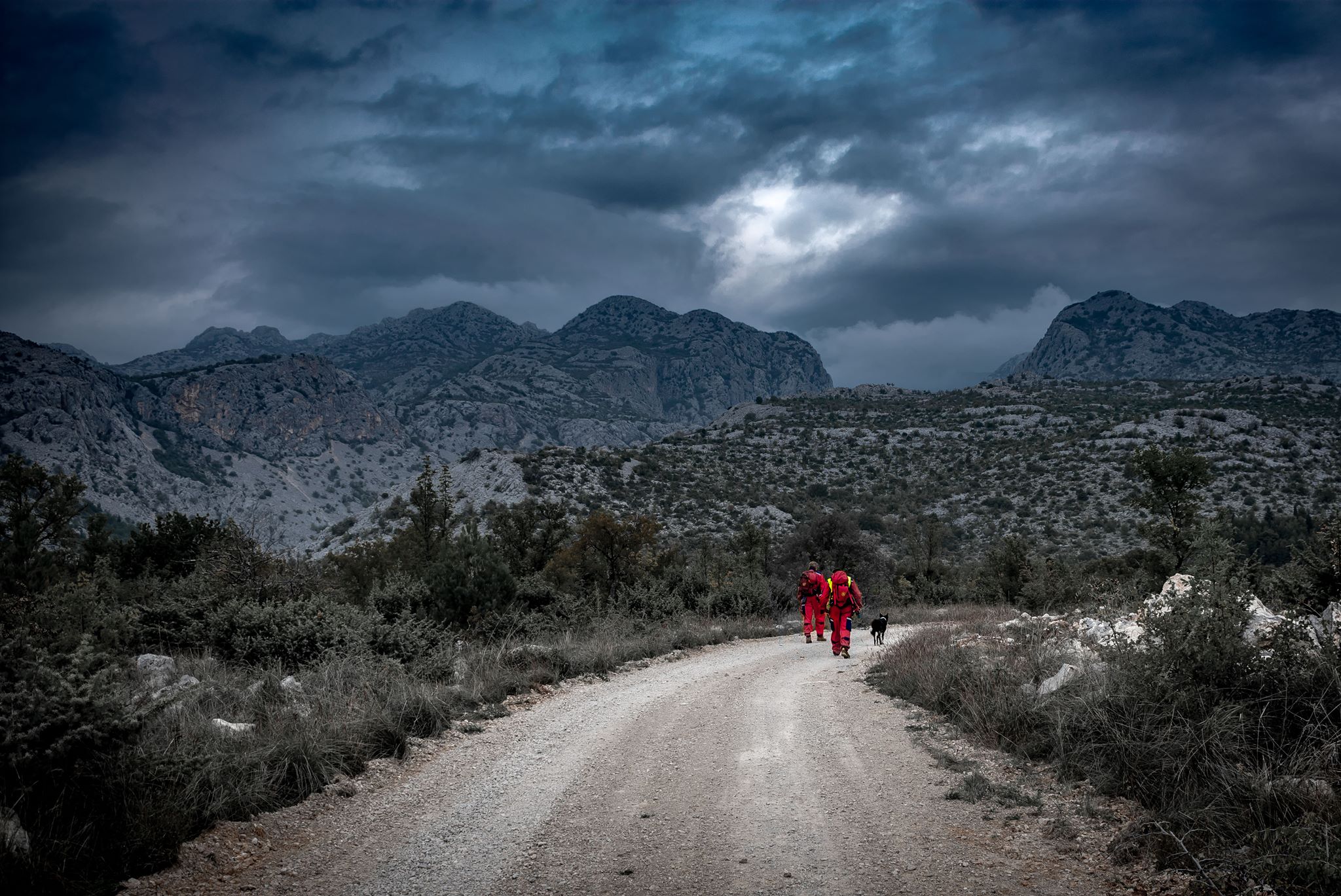
HGSS The Croatian Mountain Rescue Service members entering Paklenica under foreboding skies © HGSS The Croatian Mountain Rescue Service
I've really been on so many expeditions with HGSS. My station are on duty in the season at National Park Paklenica and I'm now the coordinator. Climbers from all around the world come and so there are many interventions. None of them are easy because the terrain is incredibly difficult. You really have to be in shape and know the techniques inside out.
I'm very proud of my statistics. Everyone I've rescued, who was alive when I reached them, is still living today. Unfortunately, not everyone we reach is alive when we arrive.
I remember one time, my husband and I were having dinner. We were arguing about the techniques and knots for moving a stretcher down a vertical climb. The training is so intense, you really have to know it well, and I guess that's just the kind of people that we are, that we would be arguing about it in our free time. Ha! He told me, "Why do you care? You'll never have to do that," because usually, it's really strong guys who do that specific job. If you're on a 400-metre-high section of rock, it really takes a lot of muscle.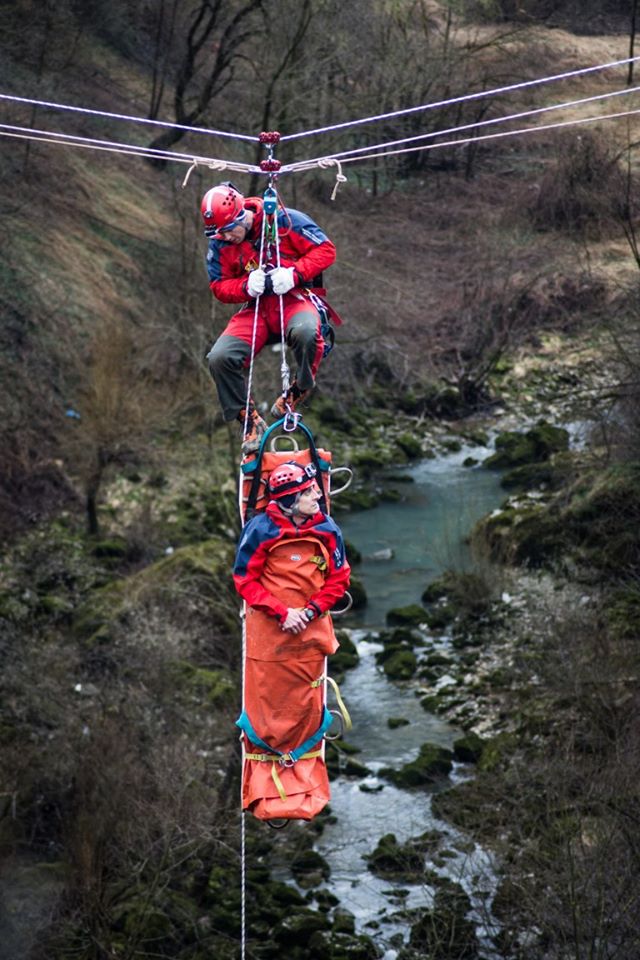
Ascending from a valley floor or descending from a mountain peak with a stretcher is a technically difficult operation, often hindered by darkness and adverse weather conditions. It requires a lot of training and a lot of muscle © HGSS The Croatian Mountain Rescue Service
In the evening, just two days later, we were called out to rescue an Italian guy who broke his leg on Anića Kuk. It's a really mighty part of the stone. And the leader of the expedition asked me to go on the stretcher. They pull you down on the ropes and you have to push very hard to keep the stretcher, the person you're carrying and yourself away from the rock, while balancing the weight of all three. It was dark, raining and with lots of Bura, the incredibly strong wind that sometimes hits us. That's probably my most memorable rescue.
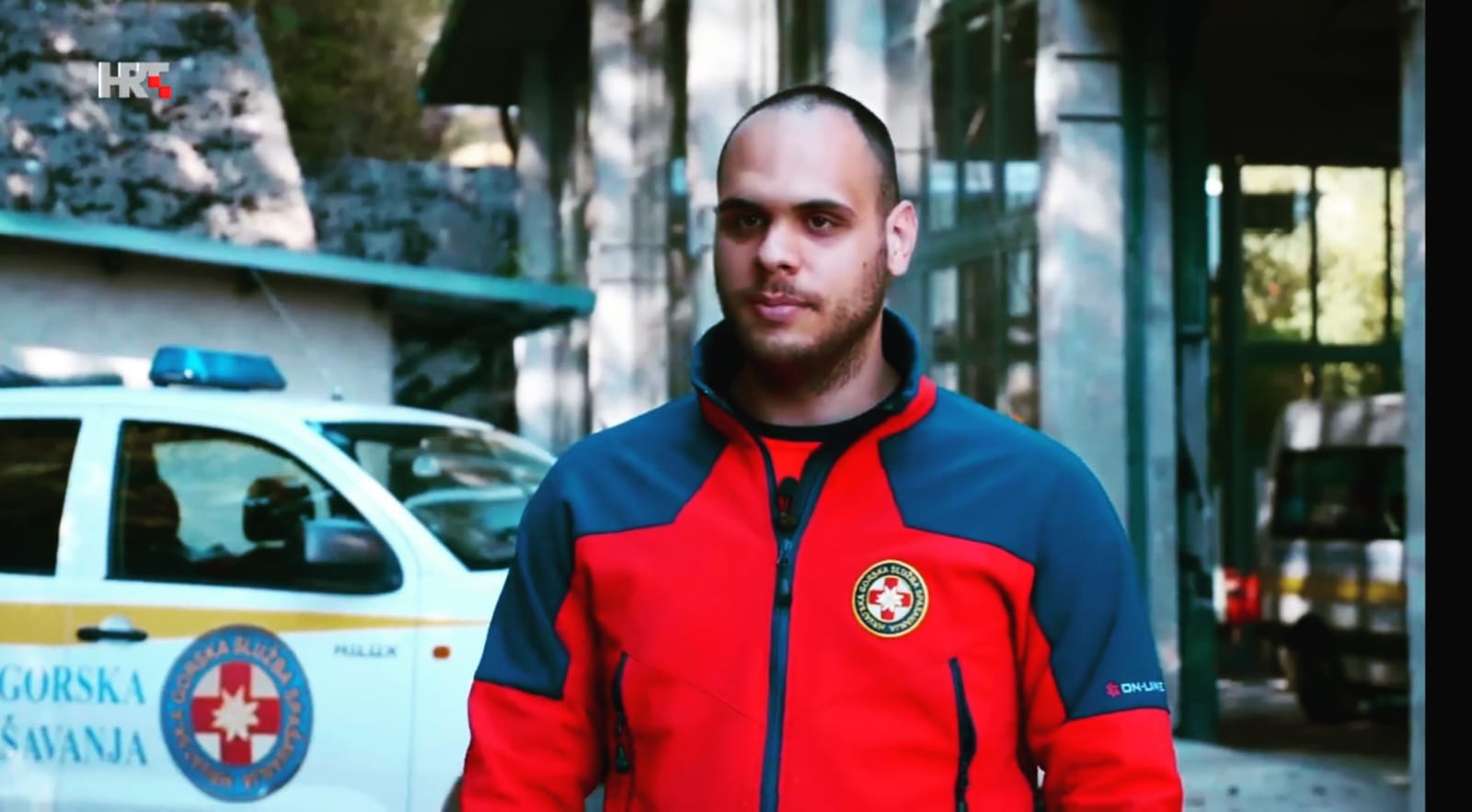
Petar Prpić, firefighter and volunteer for HGSS The Croatian Mountain Rescue Service
My name is Petar Prpić, I'm 25 years old and I'm from Hrvatska Kostajnica, just on the Croatian-Bosnian border. My station is in Novska. In my full-time job I'm a professional firefighter. I guess I have two dangerous jobs. Well, one job and one hobby.
I've always been interested in the outdoors – mountaineering, hiking, canoeing. But, that's not why I joined HGSS The Croatian Mountain Rescue Service. I just wanted to help people. I don't know, I guess it's just something in me.
We have a lot of rivers in our area. During the times of flood, we get a lot of call-outs. Our part of the country has a high percentage of elderly people in the population. A lot of them live in small villages, on the edge of the forest. We get a lot of call-outs for searches. Especially in the autumn when people go out looking for chestnuts or mushrooms. But, like all the stations in Croatia, we are here year-round if there are any actions in other parts of the country that need us.
In some areas, HGSS The Croatian Mountain Rescue Service are frequently called out in response to flooding. This picture shows HGSS members on operation during the 2014 floods. In that year, flooding across the whole region was so bad that HGSS members operated not only in Croatia, but also donated their services to neighbouring Bosnia and Serbia © HGSS The Croatian Mountain Rescue Service
I was just on the search in Biokovo. The head of service called me and asked me to go. I first had to get some free days from my job. I called my boss, Zvonimir Ljubičić, chief of the fire department. He's great, very understanding, and he gave me permission. Two years ago I was called to Rab. Very hard operation, very difficult terrain.
Late last summer, we were called out to look for an older man near Glina. It was around 11 o'clock in the evening. He'd gone to look for mushrooms in the afternoon and never came back. Police were there and they sent for us.
The man had a cell phone on him, but there was no signal. There was no location given off the phone. We were a team of four, split into two teams. We went up into the woods above Glina and concentrated our search on areas where we could see there was no telephone signal on our phones. We were yelling in the dark. After an hour of search, someone answered. He'd been missing since 2pm. We found him at 2am. He was just lying there, uninjured but unwell, unable to move.
The reason it sticks in my mind is that the next day, in the morning, his daughter called me. She was so thankful, so emotional. For sure we saved his life. None of the other emergency services who were present could find him. It was down to us. We finished the operation at about 6am and then all four of us had to go immediately to our regular jobs.
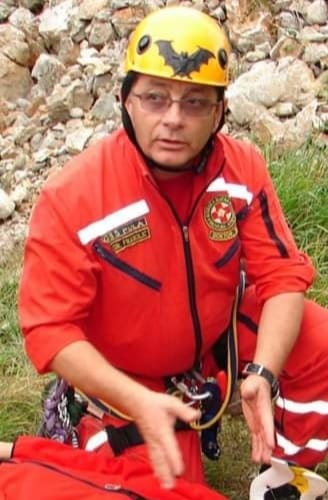
Mario Franolić, physician, ex-commando and volunteer for HGSS The Croatian Mountain Rescue Service
My name is Mario Franolić and I'm 60 years old. I'm the chief of the mountain rescue service in Istria. I travel throughout Croatia because I'm also an instructor for the medical commission of HGSS. I was born on island Krk. I'm based in Pula although I work in Rijeka. I travel a lot between the two. I've been with HGSS The Croatian Mountain Rescue Service for 18 years.
In my day job, I'm a physician. I am a senior mentor at the Institute for Underwater and Hyperbaric Medecine in the Clinical Hospital Rijeka. I'm an expert in my field of emergency medecine. I've been doing it for almost 30 years.
When I was young, I trained to be a physician in Belgrade. It was then the best medical faculty in Yugoslavia. At the same time, I also started spelunking (cave exploration). I've been doing it since 1978. Later, I was a physician in the military underwater commando unit. I lived in Austria for five years, but when I came to Pula, they were just starting the HGSS The Croatian Mountain Rescue Service station here. They asked me for help because they didn't have any medical professional on the team. I accepted. It would be a waste not to use all these skills I have.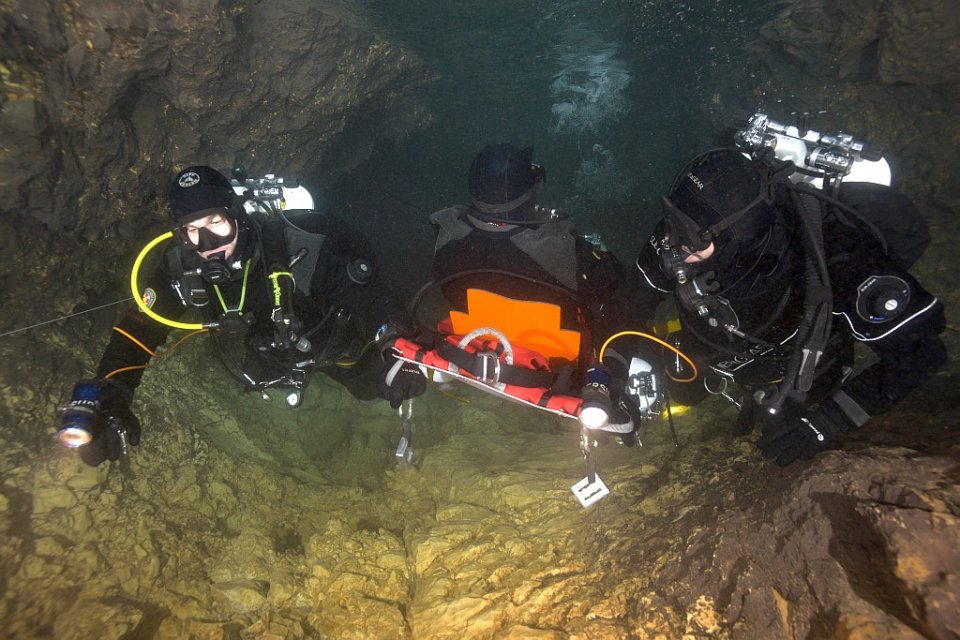
Specialist teams from HGSS are trained in underwater rescue from caves. Such caves exist all over Croatia in the karst rock, and also on some islands © HGSS The Croatian Mountain Rescue Service
Sometimes, our status as volunteers can give us problems. Although we have official duties, we are more like an NGO than something like the police. There can be legal implications. I remember one situation, very acute because a paraglider fell from the sky. None of his colleagues saw him fall. Paragliders go into the air together, but then they each branch off to do their own thing.
We had no idea about the location. We started from the last point of sighting, knowing that it could be very far from the place where he actually fell. But, we had to start somewhere. We had one mobile phone signal direction. But, you need three in order to locate someone. We only had a line on the map.
In the past, HGSS The Croatian Mountain Rescue Service sometimes had difficulties because the telephone companies wouldn't give us the information we needed in order to triangulate the position of a missing person. They would only give it to the police. But, it's a race against time. We searched for this man all day and all night. In the morning, some Croatian paragliders made private contact with a guy from the phone company. They begged him to release the information we needed. Although he could lose his job, giving such information to private citizens, he did it.
We found the man about 150 metres from where we were. Sadly, he was already dead. It was very small comfort to see that he had died instantly, on impact. It's unbearable when you reach someone you could have saved if only you had got there quicker, especially in an instance such as this, where we were hindered by a lack of information that was available. I think it moves more quickly now, but still we have to go through the police.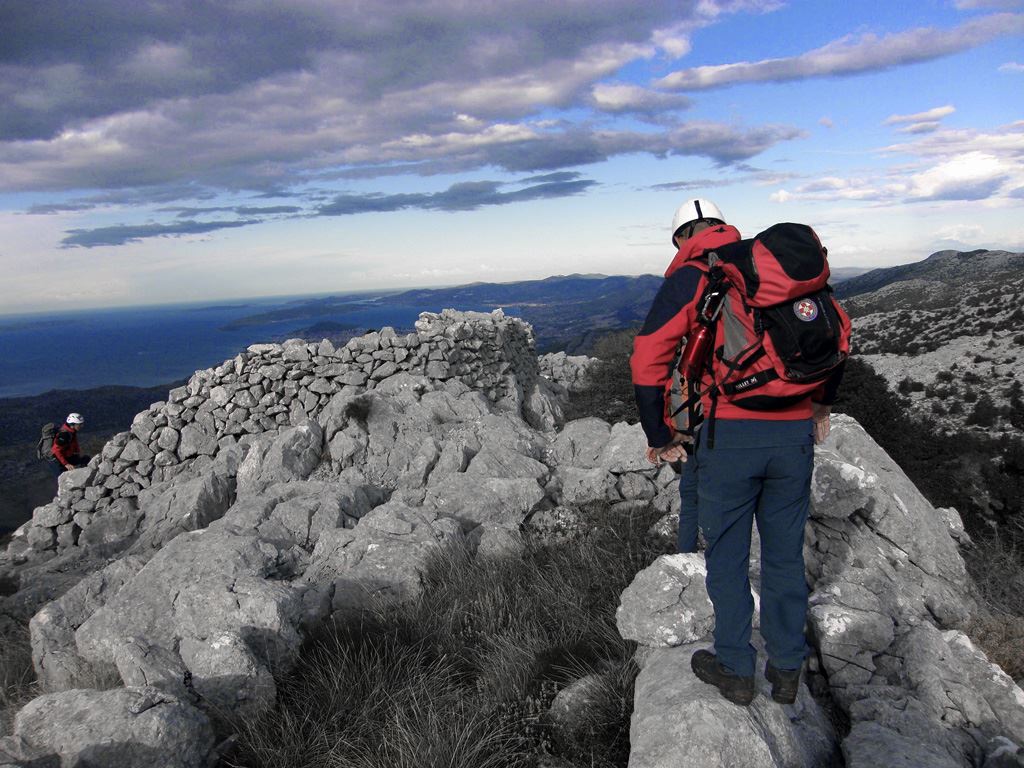
© HGSS The Croatian Mountain Rescue Service
One of the most emotional operations I went on was around five years ago, the rescue of a young girl - maybe two and a half to three years old – who got lost in the woods in a small place in central Istria. She chased into the forest after some dogs around 10 or 11 in the morning. The family saw immediately that she had disappeared and started to search. About two hours later, we were called out. It was impossible for the family to find her.
About 300 people came – my station, the Rijeka station, hunters, firemen, police and volunteers. In such an operation, the police are the lead service. But, 99% of the time they leave the organisation of the search to HGSS The Croatian Mountain Rescue Service. We are the only organisation who is very well educated in organising searches. When other people do searches, they use intuition. But, people all have different intuition. It can be chaotic. We are highly trained for this. There are procedures, recognised internationally, that we follow. We found her early in the morning, at around 7 o'clock. The dogs were lying on each side of her, giving her warmth.
All photos courtesy volunteers and HGSS The Croatian Mountain Rescue Service
Flights to Croatia: Eurowings Boosts Traffic in September, 76 Weekly Operations
August 17, 2020 - The latest news from around Croatia’s airports for flights to Croatia with updates for Zagreb, Split, Dubrovnik, Rijeka, Zadar, and Osijek.
Croatian Aviation reports that Eurowings, a low-budget German airline owned by the Lufthansa Group, has announced its flight schedule for September this year.
The company was among the first to establish regular traffic to Croatia, but as the end of the summer season approaches, Eurowings will also reduce the number of weekly flights to specific destinations.
Find the complete flight schedule to Croatian destinations below.
40 operations a week to Split
Split Airport will still have the largest number of Eurowings flights. Moreover, the number of weekly flights in September will be higher than in August!
Split - Dusseldorf will operate 4 times a week (Tuesdays, Thursdays, Saturdays and Sundays), one flight less per week compared to August,
Split - Hamburg will operate 4 times a week (Mondays, Tuesdays, Saturdays and Sundays), one flight extra than in August,
Split - Cologne will operate 5 times a week (Tuesdays, Thursdays, Saturdays twice a day and Sundays), one extra flight than in August,
Split - Stuttgart will operate 4 times a week (Mondays, Thursdays, Saturdays and Sundays),
Split - Hannover will operate once a week, on Saturdays,
Split - Berlin will operate twice a week (Tuesdays and Saturdays), one extra flight compared to August.
Rijeka and Zadar see reduced traffic, the line to Osijek is canceled
As for the traffic to the three airports mentioned above, the number of weekly frequencies will decrease in September:
Rijeka - Dusseldorf will operate once a week, on Saturdays (one flight less per week compared to August),
Rijeka - Hamburg will operate once a week, on Sundays,
Pula - Dusseldorf will operate once a week, on Saturdays,
Zadar - Cologne will operate once a week, on Saturdays,
Zadar - Stuttgart will operate twice a week until September 9, after the mentioned date once a week, on Sundays,
Osijek - Stuttgart line will not be in operation in September this year.
Eurowings returns to Dubrovnik
As announced earlier, Eurowings will re-establish traffic to Dubrovnik in September. Initially, the company planned to launch four lines, but canceled the line from Cologne.
The following lines are planned for September this year:
Dubrovnik - Dusseldorf will be in traffic once a week, on Sundays,
Dubrovnik - Berlin will be in traffic once a week, on Sundays,
Dubrovnik - Hamburg line will be open once a week, on Sundays.
Zagreb connected with Stuttgart and Cologne
In September, Eurowings will continue to operate two routes to Zagreb Airport, from Stuttgart and Cologne.
Zagreb - Stuttgart will operate 4 times a week, on Mondays, Wednesdays, Fridays and Sundays,
Zagreb - Cologne will operate 5 times a week, on Mondays, Wednesdays, Thursdays, Fridays, Sundays, which is one flight more than in August.
In total, Eurowings will have 76 weekly operations (takeoffs and landings) at 6 Croatian airports in September.
For the latest travel info, bookmark our main travel info article, which is updated daily.
Read the Croatian Travel Update in your language - now available in 24 languages!
HNL Round 1 Recap: Dinamo Crush Lokomotiva, Hajduk Better than Istra at Poljud
August 17, 2020 - The Croatian First League first round of the 2020/21 season was held from August 14 to 16, 2020. The opening round saw Dinamo embarrass 2019/20 season runners-up Lokomotiva, while Hajduk started with a win at home. Due to epidemiological reasons, all games were played without spectators.
Varazdin v. Gorica (1:5)
Varazdin and Gorica opened the 1st round on Friday, August 14, 2020, in Varazdin.
Spikic scored the first goal for Gorica in the 39th minute for 0:1 at the half. Djurasek equalized in the 63rd for 1:1. A Mudrinski goal in the 81st put Gorica back in the lead, which was followed by three goals from the 90th minute by Doka, Canadjija, and Mudrinski for a final score of 1:5.
Varazdin is currently in 9th place with 0 points, while Gorica is in 2nd with 3.
Rijeka v. Sibenik (2:1)
Rijeka and Sibenik met on Saturday, August 15, 2020, at Rujevica stadium.
It was Sibenik to take the lead in the 9th minute thanks to a goal by Bulat - and Rijeka's Yakete didn't equalize until the 84th minute! A 90th-minute goal by Muric ultimately gave Rijeka the win.
Rijeka is currently in 4th place with 3 points, while Sibenik is in 7th with 0.
Osijek v. Slaven Belupo (0:0)
Osijek and Belupo met on Saturday, August 15, 2020, at City Garden Stadium.
A double yellow for Skoric has Osijek playing with 10 men from the 30th minute. Neither team was able to score.
Osijek is currently in 5th place with one point, while Belupo is in 6th with one point.
Hajduk v. Istra 1961 (2:0)
Hajduk and Istra met at Poljud on Sunday, August 16, 2020.
While the first half went without goals, it was Dimitrov to put Hajduk in the lead for 1:0 in the 72nd minute. Gyursco increased Hajduk's lead to 2:0 with a goal in the 83rd minute, which was the final result.
Hajduk is currently in 3rd place with 3 points, while Istra is in 8th with 0.
Dinamo v. Lokomotiva (6:0)
Dinamo and Lokomotiva closed out the first round on Sunday, August 16, 2020, at Maksimir stadium.
Two quick goals by Majer in the 6th and 27th minute put Dinamo in the 2:0 lead at the half. Gavranovic increased Dinamo's lead to 3:0 in the 50th minute, while goals by Orsic and Ivanusec in the 78th and 79th minutes made it 5:0. Andric scored the final goal of the match ten minutes later for the 6:0 result.
Dinamo is currently in first place with 3 points, while Lokomotiva is in last with 0.
You can see the full HNL table here.
To read more about sport in Croatia, follow TCN's dedicated page.
Flights to Croatia: LOT Plans to Operate 8 Lines to Croatia in September
August 12, 2020 - The latest news from around Croatia’s airports for flights to Croatia with updates for Zagreb, Split, Dubrovnik, Zadar, and Rijeka.
Croatian Aviation reports that Polish LOT airlines have announced its flight schedule for September this year, in which it intends to fly on eight international routes to five Croatian airports. We bring you the flight schedule below.
Lines from Warsaw to Rijeka and Zagreb
The Warsaw - Zagreb line continues to operate daily in September, on E170 and 175 aircraft, with a capacity of 70 and 82 seats, respectively.
The Warsaw - Rijeka line will be in operation until September 13, once a week as before, on Sundays. In September, smaller capacity aircraft will operate on the route. The line was originally scheduled to run until October 18, but the company will close it in the middle of next month.
LOT lines to Split
Of the currently active LOT lines to Split, only one will operate in September. The Warsaw - Split line continues to operate once a week throughout September, every Sunday, with aircraft type B737-800 and E195. The following lines end in August:
Lublin - Split will be in traffic until August 28, once a week (Friday),
Katowice - Split will be in operation until August 30, once a week (Sunday),
Poznan - Split will be in operation until August 31, once a week (Monday).
Gdansk - Split will be in operation until August 26, once a week (Wednesday).
Two lines to Zadar
LOT will keep traffic on two lines in Zadar through September; the Warsaw - Zadar line continues to operate once a week, every Saturday, as well as the Rzeszow - Zadar line, which will operate until September 19, also on Saturdays. The following LOT lines end in August:
Gdansk - Zadar will be in operation until August 28, once a week (Friday),
Szczecin - Zadar will be in operation until August 27, once a week (Thursday),
Krakow - Zadar line will be in operation until August 25, once a week (Tuesday),
Bydgoszcz - Zadar line will be in operation until August 29, once a week (Saturday).
Three lines to Dubrovnik in September
LOT will keep three lines to Dubrovnik in September this year, two from Poland and one from Hungary. The Warsaw - Dubrovnik line will operate four times a week (Mondays, Wednesdays, Thursdays and Saturdays), the Krakow - Dubrovnik line once a week, on Saturdays, while the Budapest - Dubrovnik line will operate once a week, on Sundays, until September 27.
The following LOT lines will not operate in September this year:
Katowice - Dubrovnik will be in operation until August 27, (Thursday),
Poznan - Dubrovnik will be in operation until August 30, (Sunday),
Wroclaw - Dubrovnik will be in traffic until August 29, (Saturday),
Gdansk - Dubrovnik will be in operation until August 25, (Tuesday).
Of the 20 currently active lines to Croatia, the Polish national company will operate only eight next month.
For the latest travel info, bookmark our main travel info article, which is updated daily.
Read the Croatian Travel Update in your language - now available in 24 languages
Project for Lowland Railway to Rijeka Starts
ZAGREB, Aug 10, 2020 - The HZ Infrastruktura company is embarking on a project to upgrade the existing and build a second track of the railway running from Hrvatski Leskovac to Karlovac, with the value of the project being the highest of all other Croatian railway projects so far, amounting to HRK 2.3 billion, not including VAT, Vecernji List daily says.
The tender for the project, which will be co-financed by the European Union, which will provide 85% of the funding, will be published in September.
The Hrvatski Leskovac section is part of a railway running from Rijeka to the border with Hungary, and work has already started on upgrading the single-track line to a dual track from Zagreb to the border. Work is already underway on the section Dugo Selo-Krizevci and preparations are underway for work to begin on the section running from Krizevci to the state border.
Work on the Hrvatski Leskovac - Karlovac section will thus also launch work on upgrading the railway from Zagreb to Rijeka to a modern, dual track.
The Rijeka-Zagreb-Budapest railway is part of the Mediterranean TEN-T corridor.
The implementation of this project as well as other sections on which work has been underway or is planned will increase the competitiveness of the port of Rijeka by improving its transport connectivity to central European markets, the daily says.
Transport Minister Oleg Butkovic has said that the entire project could be completed by 2027.
Natural History Museum Rijeka Partner in Four EU Projects
August 5, 2020 - The Natural History Museum Rijeka participates as a partner in as many as four EU projects. Within them, it has so far carried out numerous activities, from research and protection of biological diversity to the design of educational programs.
T.portal reports that Primorje-Gorski Kotar County, the founder of the institution, announced on Wednesday that the museum is a partner in the projects "LIKE - Life on the Karst Edge", "CLAUSTRA + - Cross-border destination of cultural and green tourism Claustra Alpium Iuliarum", "KRASn'KRŠ - Protection and valorization heritage and the development of sustainable tourism in the cross-border karst landscape and the Cultural and Tourist Route "Frankopan Roads".
The area of interest of the project "LIKE - Life on the Karst Edge" is the karst edge, a series of steep rocks and limestone slopes in Slovenia and Croatia in northern Istria, across Ćićarija to Učka.
In this area, the long-term interaction of man and nature has produced distinctive biological, cultural and aesthetic values, and maintaining this relationship is necessary for their preservation, the county points out.
The rich natural potential of the area is under increasing pressure from visitors, but also long human activities, given the proximity of densely populated areas on the Koper-Trieste and Opatija side.
Within this project, the museum protected and restored biological diversity, by establishing a joint program for the management and monitoring of Natura 2000 with Slovenian partners.
Necessary equipment for additional field and laboratory research was procured, a special part of the Botanical Garden next to the museum building was arranged, intended for the protection of plant species in a special protection regime.
The Natura 2000 educational program was designed and implemented, within which online materials were prepared and more than 40 workshops were conducted in the museum and other locations.
The goal of the "CLAUSTRA +" project is the tourist evaluation of the remains of the ancient defense complex Claustra Alpium Iuliarum from Rijeka to the area along the Soča in Slovenia.
The museum participated in about fifty lectures, workshops and guided tours in the museum and in the field. The "Roman Night in Nature" event was held twice, next to the preserved remains of the defensive wall near Studena, north of Rijeka.
Field research was carried out with the aim of establishing a model of vegetation in Roman times, and a Roman garden with plants used by the Romans and which once grew in the area of the Claustra complex was opened in the Botanical Garden of the museum.
As part of the "KRASn'KRŠ" project, work was done on adapting the tourist offer to the needs of modern visitors in connection with the four existing karst heritage sites in Sežana, Škocjan Caves, Brod na Kupi and Punat, which were upgraded to interpretation centers and the museum developed an umbrella interpretation strategy.
A multimedia interdisciplinary presentation of karst and a traveling exhibition was designed and the first Karst Festival was held.
Among other activities, the Natural History Museum Rijeka traced an educational trail in the wider area of Mali Platak and opened the Visoki Krš Interpretation Center as part of the arrangement of a new permanent exhibition in the Zrinski Castle in Brod na Kupi.
The museum is a partner in the project "Cultural and tourist route Frankopan Roads", with the aim of protecting and presenting the cultural heritage of the noble Frankopan family in the Primorje-Gorski Kotar County, which includes 17 castles and three sacral buildings.
The permanent exhibition in Kaštel Zrinski will show the natural heritage of the Kupa Valley and Gorski Kotar in an attractive way and with the use of the most modern museography approaches and technologies, from the Kupa and life in it, mountain forests and their inhabitants to the highest mountain peaks.
Visitors will be able to learn more about living conditions in different habitats, about rare and endangered species, but also about the traditional coexistence of man and nature in this area. The arrangement of this exhibition is expected at the end of 2020, Primorje-Gorski Kotar County reported.
To read more about lifestyle in Croatia, follow TCN's dedicated page.


